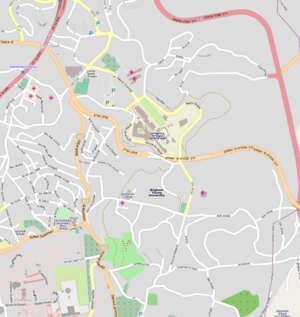
The Cave of the Patriarchs or Tomb of the Patriarchs, known to Jews by its Biblical name Cave of Machpelah and to Muslims as the Sanctuary of Abraham, is a series of caves situated 30 kilometres (19 mi) south of Jerusalem in the heart of the Old City of Hebron in the West Bank. According to the Abrahamic religions, the cave and adjoining field were purchased by Abraham as a burial plot, although most historians believe the Abraham-Isaac-Jacob narrative to be primarily mythological. The site is considered a holy place in Judaism, Christianity, and Islam.
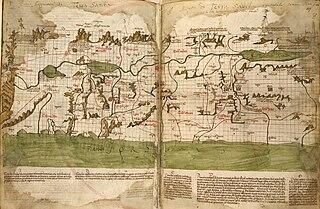
The Holy Land is an area roughly located between the Mediterranean Sea and the eastern bank of the Jordan River, traditionally synonymous both with the biblical Land of Israel and with the region of Palestine. Today, the term "Holy Land" usually refers to a territory roughly corresponding to the modern states of Israel and Palestine. Jews, Christians, Muslims, and Baháʼís regard it as holy.
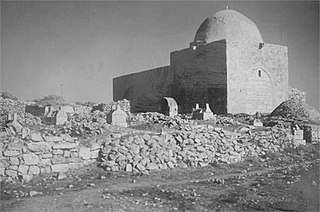
Rachel's Tomb is a site revered as the burial place of the Biblical matriarch Rachel. The site is also referred to as the Bilal bin Rabah mosque. The tomb is held in esteem by Jews, Christians, and Muslims. The tomb, located at the northern entrance to the Palestinian city of Bethlehem, next to the Rachel's Tomb checkpoint, is built in the style of a traditional maqam, Arabic for shrine.

The Tomb of Absalom, also called Absalom's Pillar, is an ancient monumental rock-cut tomb with a conical roof located in the Kidron Valley in Jerusalem, a few metres from the Tomb of Zechariah and the Tomb of Benei Hezir. Although traditionally ascribed to Absalom, the rebellious son of King David of Israel, recent scholarship has dated it to the 1st century AD.

Ramot, also known as Ramot Alon, is an Israeli settlement and neighborhood in East Jerusalem. Ramot was founded in 1974 as one of Jerusalem's so-called "Ring settlements", considered illegal under international law. In 2020, Ramot had a population of 50,400 of which 75% consists of Haredi Jews.
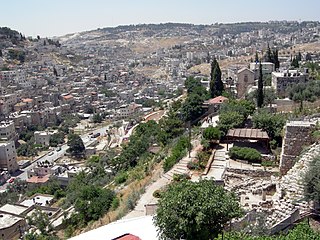
Kidron Valley is the modern name of the valley originating slightly northeast of the Old City of Jerusalem, which then separates the Temple Mount from the Mount of Olives, and ending at the Dead Sea. Beyond Jerusalem it continues in a general south-easterly direction through the Judean desert in the West Bank, reaching the Dead Sea near the settlement of Ovnat, and descending 4,000 feet (1,200 m) along its 20-mile (32 km) course.

Tourism in Israel is one of the country's major sources of income, with a record 4.55 million tourist arrivals in 2019. Tourism contributed NIS 20 billion to the Israeli economy in 2017, making it an all-time record. Israel offers a plethora of historical and religious sites, beach resorts, natural sites, archaeological tourism, heritage tourism, adventure tourism, and ecotourism. For practical reasons, this article also covers tourism in the Israeli-occupied West Bank and the occupied Golan Heights, since it is closely interconnected with the mass tourism in Israel. The Holy Land has been over the milienia amongst the most visited lands in the world.

Wadi al-Joz, also Wadi Joz, is a Palestinian neighborhood in East Jerusalem, located at the head of the Kidron Valley, north of the Old City of Jerusalem. The population of Wadi Joz is 13,000. It is located 750 meters above sea level in the Kidron Valley.

Tel Maresha is the tell of the biblical Iron Age city of Maresha, and of the subsequent, post-586 BCE Idumean city known by its Hellenised name Marisa, Arabised as Marissa (ماريسا). The tell is situated in Israel's Shephelah region, i.e. in the foothills of the Judaean Mountains, about 2 kilometres (1.2 mi) southeast of Beit Gubrin.

Bayt Jibrin or Beit Jibrin, known between 200-400 CE as Eleutheropolis, was a historical town, located in central Israel near the 1949 ceasefire line, 21 kilometres (13 mi) northwest of the city of Hebron. When residents were forced to vacate in 1948 during the Nakba, the town had a total land area of 56,185 dunams or 56.1 km2, of which 0.28 km2 were built-up while the rest remained farmland.
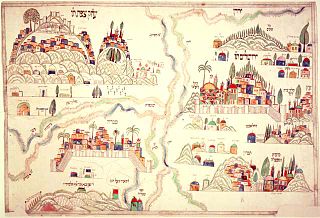
The Four Holy Cities of Judaism are the cities of Jerusalem, Hebron, Safed and Tiberias, which were the four main centers of Jewish life after the Ottoman conquest of Palestine.

The Talpiot Tomb is a rock-cut tomb discovered in 1980 in the East Talpiot neighborhood, five kilometers south of the Old City in East Jerusalem. It contained ten ossuaries, six inscribed with epigraphs, including one interpreted as "Yeshua bar Yehosef", though the inscription is partially illegible, and its translation and interpretation is widely disputed. The tomb also yielded various human remains and several carvings.

Amos Kloner was an Israeli archaeologist and professor emeritus.

The Tomb of Simeon the Just or Simeon the Righteous is an ancient tomb in Jerusalem. According to scholarly consensus, based on an in situ inscription, it is the 2nd-century CE burial site of a Roman matron named Julia Sabina. However, according to a medieval Jewish tradition, is believed to be the burial place of Simeon the Just and his students. It is located adjacent to the Cave of the Minor Sanhedrin in the Shimon HaTzadik settlement within the Sheikh Jarrah neighborhood.

Silwan or Siloam is a predominantly Palestinian district in East Jerusalem, on the southeastern outskirts of the current Old City of Jerusalem.

'Akbara is an Arab village in the Israeli municipality of Safed, which included in 2010 more than 200 families. It is 2.5 km south of Safed City. The village was rebuilt in 1977, close to the old village destroyed in 1948 during the 1947–1949 Palestine war.

The Tomb of the Prophets Haggai, Zechariah and Malachi is an ancient burial site located on the upper western slope of the Mount of Olives, Jerusalem. According to a medieval Jewish tradition also adopted by Christians, the catacomb is believed to be the burial place of Haggai, Zechariah and Malachi, the last three Hebrew Bible prophets who are believed to have lived during the 6th–5th centuries BC. Archaeologists have dated the three earliest burial chambers to the first century BC, thus contradicting the tradition.

Tombs of the Sanhedrin, also Tombs of the Judges, is an underground complex of 63 rock-cut tombs located in a public park in the northern Jerusalem neighborhood of Sanhedria. Built in the 1st century CE, the tombs are noted for their elaborate design and symmetry. They have been a site for Jewish pilgrimage since the medieval period. The popular name of the complex, which has the most magnificently carved pediment of ancient Jerusalem, is due to the fact that the number of burial niches it contains is somewhat close to that of the members of the ancient Jewish supreme court, the Great Sanhedrin, namely 71.

The tomb of Jesse and Ruth is an ancient structure located within the ruin of Deir Al Arba'een in the Tel Rumeida section of Hebron that Jewish tradition considers to be the tomb of Jesse and Ruth. The place is in area H2 of Hebron, under Israeli control.
The Bar Kokhba hiding complexes, including cliff shelters, are underground places of refuge created by Jewish rebels and their communities of the Shephelah and the Lower Galilee while preparing for the Bar Kokhba revolt, with at least the Judaean ones actually being used during the fighting. Natural caves were also used as hiding sites. The man-made hiding complexes and cliff shelters were rock-carved spaces, connected to one another by low and narrow passages. According to research, these systems were hewn by the supporters and fighters of Bar Kokhba as preparation for the revolt pursued by the Jews against the Roman Empire in 132-135 CE.

